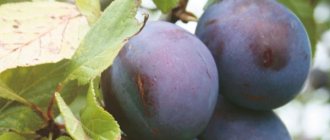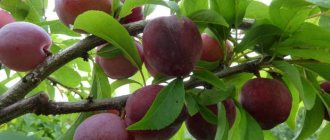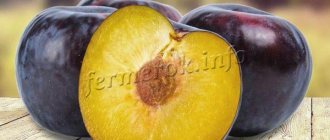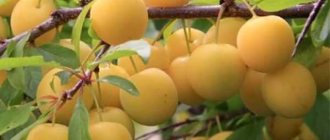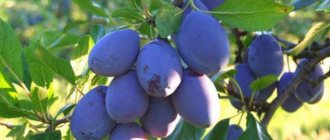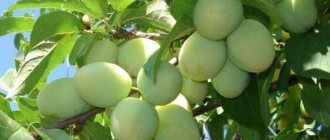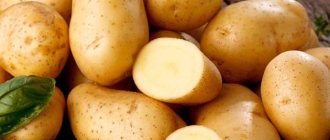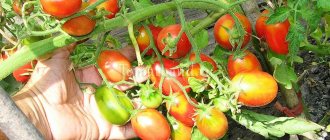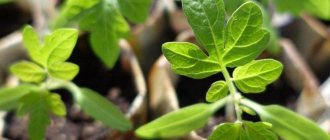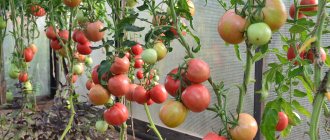- Ideal varieties for the Ural area
- Variety Pride of the Urals
- View Pearl
- Chemal gift
- Chebarkul variety
- Snow White
- Prunes of the Urals
- Golden Ural variety
- Conclusion
Plum Pride of the Urals is a type of fruit crop that is grown in the Northern regions of the country. Its main advantage is resistance to frost even at the time of flowering, therefore it is characterized by high yields regardless of the climatic conditions of growth.
Ideal varieties for the Ural area
There are a huge number of different varieties that are suitable for growing in the northern regions of the country. The following varieties are found in the Urals: Ussuri, Canadian species, Cherry plum and sloe.
The climatic conditions of the Ural region are such that plants have a minimum dormant period. The thaw occurs much later than in other areas, and frosts often occur in the spring. All varieties growing in this area must calmly tolerate such negative climatic conditions in order to be able to reap an excellent harvest.
Not all varieties of plums are self-fertile. It is best to plant such species near other plants with similar flowering periods.
Useful properties of plum
Why is plum so popular to grow? What's special about these fruits? In addition to its taste, plums have a number of beneficial properties. By deciding to grow this fruit tree on your property, you will provide yourself with an excellent source of valuable vitamins and minerals. This is especially important for residents of the Urals, where there is not such a large selection of berries and fruits grown in gardens. Among the most important components of plums are:
- cellulose;
- carbohydrates;
- proteins;
- organic acids;
- pectin;
- vitamins A, B1, B2, C, E;
- folic acid;
- potassium, magnesium, calcium, phosphorus;
- manganese, cobalt, iron, zinc, fluorine, etc.
Plum is also considered a dietary product, because... 100 grams of plum contains only 43 kcal. Growing this tree will be especially useful for those who monitor their health and adhere to proper nutrition. Plum fruits are often used in baby food. Plum fruits have the following effects on the human body:
- Eating plums is very beneficial for people who suffer from various diseases of the cardiovascular system. For example, high blood pressure, atherosclerosis.;
- Plum has a good effect on the body in case of kidney and liver diseases;
- Eating plums is often recommended for certain diseases of the gastrointestinal tract;
- plum can be a natural and safe treatment for constipation;
- Plum has long proven its effectiveness as an antipyretic. It will be useful to consume plums in fresh or dried form, plum compote for ARVI;
- plum is also often eaten by people to remove excess cholesterol from the body;
- the diuretic effect of plum fruits is explained by the potassium content in them, which removes excess water and salts from the body;
- plums have a valuable cleansing and hematopoietic effect on the body. These fruits actively promote the removal of toxins and waste from the body;
- plums are often used as a natural remedy to increase appetite;
- eating plum fruits has a beneficial effect on the nervous system, helps fight chronic fatigue, depression, and insomnia;
- plum has also earned its attention as a means of combating diseases of the organs of vision;
- Plum leaves have also found their use in folk medicine. They have anti-inflammatory and antibacterial effects. Some recipes recommend crushing the leaves and applying them to wounds. Decoctions and infusions are also prepared from plum leaves. Plum leaves effectively fight stomatitis;
- plums have also found their use in cosmetology. They are known to have a rejuvenating effect that restores elasticity and smoothness to the skin. Various masks are made at home using plum pulp. You can also find plums as an ingredient in ready-made masks and creams in stores.
Read more: Cherry plum Zlato Scythians description of the variety pollinators
Variety Pride of the Urals
The height of the tree of the Pride of the Urals variety is small, only 3-4 m. This species is quite productive. Gardeners can collect up to 20 kg of selected products from a tree. If the quality of care is improved (protected from low temperatures and fertilized with high quality), then the yield can be increased to 30 kg. The crown of the Pride of the Urals plum tree has a narrow pyramidal shape. Good frost resistance is noted. The tree can bloom even at temperatures of -30 °C, without losing the quality of the crop.
The fruits of the Pride of the Urals variety are small.
- Weight is only 8-10 g.
- Elongated shape.
- The peel is dense, red.
- The surface is covered with a waxy coating.
- The bone is difficult to separate from the pulp.
Due to the fact that this species contains a high concentration of ascorbic and folic acids, its taste is slightly sour. Despite this, it is pleasant, which makes the product universal in terms of use.
Diversity and characteristics of plum varieties for the Urals
The difficulties of growing plums in the Urals and Siberia include the following:
- spring frosts destroy the plant;
- the risk of damping off in winter increases;
- The root system freezes during winters with little snow.
For a gardener, the question of which varieties are best to plant is important. They choose not only those that are winter-hardy, but those that can withstand the cold winds characteristic of a sharply continental climate. You should not choose those that are tall. Medium-sized shrubs and trees take root better and withstand the winter. But a big role for summer residents is played by the description of the fruits and their taste.
Pride of the Urals
The variety was obtained by pollinating the Zhemchuzhina plum back in the 50s of the 20th century. Since then, it has been zoned by Ural gardeners. But it is popular both in the Caucasus and Siberia. In addition to its resistance to frost below 30 degrees, plums are distinguished by:
- high yields of up to 35 kilograms per tree;
- precocity;
- plums ripen after 120 days;
- tree height is 4 meters;
- reddish fruits of medium weight.
Caring for the variety is easy. It does not require pruning and grows quickly. Fruits with a sweet and sour taste and tender pulp. They are universal in purpose. This plum variety requires pollinators.
Chemal's Gift
On a medium-sized tree, in the 3-4th year, round fruits with a deep funnel and a slightly noticeable seam appear. Under the orange skin with a red blush there is tasty greenish-yellow flesh. The fruits are harvested in the second half of August. Plum tolerates winter well, but is not resistant to damping off.
Pearl of the Urals
The variety was bred at the South Ural Research Institute of Fruit and Vegetable Growing and zoned since 2006. A medium-sized tree with a spreading crown has medium foliage. Bears fruit on mixed and fruit shoots. The plums ripen large, weighing up to 25 grams each, with a smooth green skin. The variety has a juicy pulp of a delicate structure with an elongated stone. In terms of taste, plums are given 4.7 points. There are more sugars in fruits than acids.
The culture is partially self-fertile, with average ripening periods. Shoots are rarely damaged by frost in winter, but there is partial damage to flower buds by frost in spring.
Chebarkulskaya
The plum tree reaches a height of 3.5 meters and has a spreading crown. The variety has blue, large fruits, weighing 30 grams each. The value is in the tasty pulp, medium-fiber, greenish-yellow in color.
Snow White
A specially bred variety for the Urals and Siberia tolerates frosts up to 40 degrees. The tree is not tall, but with a spreading crown of 4 meters. The surface of the plum fruit is yellow with a whitish waxy coating. With good care, they reach a weight of 30 grams, and the yield per tree is 20-30 kilograms. The plum tastes sweet with a slight sourness.
Ural prunes
The mid-late ripening crop is famous for its dark blue, almost black fruits. They weigh 15 grams, are elongated, have a sweet taste with a slight tartness. The medium-sized stone is easily separated from the pulp. The variety is winter-hardy, high-yielding, with excellent transportability. The fruits are good in dried form, compotes.
Ural golden
Appeared in the State Register in 2004. The appearance and taste of the fruits of the variety are of excellent quality. The main color of the skin is yellow, the flesh is the same color. The bone inside is medium in size and can be easily separated. Plum has good transportability. Harvests are harvested from a medium-sized tree annually, starting from the 4th year of life. The advantage of growing plums is its resistance to diseases and low frost damage.
Kuyashskaya
The plum is medium-sized, blooms and bears fruit on short shoots . The fruits are round without a seam, with a smooth surface of a reddish color. The pulp is yellow, slightly fibrous. It tastes more sugar than acid. Separability of the stone from the pulp is average. Fruiting periodically.
The tree is distinguished by the fact that it easily tolerates spring frosts down to minus 5 degrees.
Uyskaya
The plum variety has a sparse, non-thickening crown with a tree height of 3 meters. With an average yield of up to 15 kilograms per plant, it is valued for its original orange-colored fruits with a bright blush. The pulp is fine-grained, juicy, sweet. Plums are well pollinated by the Ussuri type of stone fruit crop.
See also
How to properly dry plums at home with your own hands, TOP ways to make prunesRead
Shershnevskaya
The variety was obtained by open pollination of the Ussuri plum. The plant is valued for:
- aroma and taste of fruits;
- good separation of the bone from the pulp;
- versatility of purpose;
- slight frost damage;
- resistance to fungal infections;
- annual fruiting;
- high yields.
Plum blossoms and bears fruit on bouquet branches.
Krasnoselskaya
The tree with a spreading crown has round leaves with a short pointed tip, green in color. Plum berries have yellow flesh, and the skin on top is smooth and red. The fruit weight is often 20 grams or more. Ripe plums are used for processing. The harvest ripens late.
Although the variety is winter-hardy, it is sometimes damaged by spring frosts.
Aylinskaya
The hybrid was bred by crossing a sandy type of crop with a varietal Golden plum. The tree grows weakly, but has a wide crown. The fruits have a purple coating with a strong waxy coating. Plums with light, yellowish-green flesh, sweet, with an easily separated pit. The tree blooms in May and ripens in August.
Uvelskaya
The seedling obtained by open pollination has average height and foliage. The leaves are rounded with a blunt base and a pointed tip of a rich green color. The fruits appear on shortened shoots. They reach a mass of 23-24 grams. The pulp has high sugar content and low acidity. Plum tolerates transportation well.
The crop is a late-ripening species that can withstand frost and rarely suffer from fungal infections.
Golden Niva
The hybrid belongs to plants of medium maturity. Plum is distinguished by the golden-sunny color of its round fruits. And their flesh is juicy, tender, sweet. The medium-sized stone is easily separated from the pulp. The tree is of average 2-meter height, with a wide crown, the branches inside of which are raised upward. The crop bears fruit regularly.
Manchurian beauty
The plum combines the qualities of 3 types: Chinese, Ussuri and Simon. A dwarf with a thick, rounded crown has a number of advantages:
- Rapid awakening of the buds leads to strong branching of the tree.
- A burgundy blush spreads on the yellow-orange background of the fruit.
- The bone is small.
- Plums reach ripeness in August-September.
- The culture transmits valuable traits well to offspring.
It is known that the plant is winter-hardy and resistant to some diseases.
Pioneer
The original variety was obtained by open pollination from selected Ussuri plum. The tree reaches a height of 3-4 meters. It has a lush spreading crown. Dark red fruits reach a weight of 18-20 grams. Plums with a smooth glossy surface, rounded base and pointed apex. The fruits are sweet and ripen in mid-August. The variety is transportable, with a yield of up to 35-40 kilograms per tree.
Yellow Khopty
Self-fertile plums were brought from China in the first half of the last century and spread throughout the Far East and the Urals. The tree is different:
- vigorous growth;
- spreading but sparse crown;
- oval leaves;
- round fruits with flattening, weighing 12-14 grams;
- yellow plums, waxy on top;
- loose pulp with a sweet and sour taste.
The bone inside is large, but easily separated from the pulp. Plums do not tolerate transportation well. They are best consumed fresh.
Ural dawns
The advantage of the variety is that it:
- ripens early: late July - August;
- pleases with fruits of 25-30 grams;
- winter-hardy;
- develops into trees with a spreading crown, a trunk height of 2.5-3 meters.
Plums have a dark red cover, with a bluish bloom, and are delicious.
Honey
One of the unpretentious varieties of crops that delight with high yields, has a delightful aroma and taste of the fruit. The prevalence of the hybrid is high and tolerates weather changes in cold climate zones. Oval fruits with transparent yellow skin reach a weight of 30-50 grams. When ripe, plums turn orange with a whitish coating and are used universally.
Commander
Plum is a columnar species, so the tree has a compact crown and a height of 2 meters. Entering fruiting in the 2nd year of life, it pleases with fruits of 50 grams. They have juicy, yellowish flesh with a refreshing sourness.
Imperial
A new columnar-type hybrid has only recently become known to gardeners in the Urals. The crown of the tree looks like a narrowed pyramid. The height of the crop with a brownish trunk reaches 2 meters. The fruits are located throughout the tree and have a round shape. And the plum pulp is golden, with a honey flavor. The variety is winter-hardy and has strong immunity to fungal infections.
Blue Sweet
Columnar varieties of plums are represented in the Urals by the Blue Sweet hybrid. The crown of the tree has no side branches and is directed upward. The pulp of the fruit is hidden under a thick skin, but it is tender and juicy. The harvest is stored fresh for a long time, and it is large and reaches up to 80 kilograms from 1 column.
View Pearl
Another variety that is characterized by winter hardiness is Zhemchuzhina Ural. Despite the fact that it was bred in the early 2000s, it has already managed to get a place in the State Register of the Russian Federation and gain recognition from many gardeners. The description indicates the average height of the tree; it reaches 3.5-4 m. The crown is wide and spreading. From each one you can collect about 20 kg of products.
Among other characteristics of the species, the following parameters should be highlighted:
- ripening dates are mid-early: the growing season lasts only 50 days from the moment of flowering;
- resistance to pests and diseases;
- resistance to harsh weather conditions;
- fruit weight is about 30 g;
- red peel;
- taste sweet and sour;
- The pulp is dense, juicy.
The best plum varieties for planting in the Urals
Gardeners in the Urals, Siberia and other northern regions are limited in their choice of fruit crops. Difficult weather and climatic conditions dictate their own rules. Most heat-loving plants will not be able to adapt to such a harsh region.
The climatic features of the Urals are predetermined by its geographical location. A significant part of the territory is the Ural Mountains. The relief is heterogeneous and dissected. Due to the fact that the region is located in the interior of the continent and has a large extent from north to south, there is an uneven distribution of precipitation not only across regions, but also within each locality.
Despite the difficult weather and climatic features of the region, with a competent approach and due attention, gardeners in the Urals manage to achieve good yields of various fruit crops.
Many novice agronomists are interested in how to properly plant plums in the spring in the Urals. Planting a fruit crop begins with the selection of planting material. According to the recommendations of experts, buy seedlings from local specialized nurseries. The ideal plum seedling is a young tree of one or two years old with a well-developed root system.
Do you want to grow a healthy and actively fruiting fruit tree? First of all, you need to choose the right place to plant the tree. The best option is a southern or southwestern slope, where there is a lot of sunlight and no drafts. To avoid freezing of the root, you should avoid the proximity of groundwater and lowlands, where water often accumulates during floods and heavy rains.
Planting plums in the Urals in the spring begins with preparing a planting hole measuring approximately 70x80 cm. The top layer of soil, rich in various nutrients and fertile substances, is mixed with wood ash, superphosphate and compost. A wooden peg should be installed in the center of the hole, which will serve as a support for the young tree. You need to plant a plum seedling carefully so as not to damage the root system. In this case, the root collar is above the surface of the earth.
In order for a fruit tree to actively grow and bear fruit well, it is necessary to provide the plant with proper care: watering, loosening and mulching the soil in the tree trunk circle, fertilizing with mineral and organic fertilizers, sanitary, rejuvenating and shaping crown pruning, treatment against insect pests and protection against fungal, bacterial and viral diseases.
Plum grown in the Urals requires special attention during preparation for winter. During this period, whitewashing and covering of the trunks is carried out. Gardeners often resort to shaping the plum into a slate, which contributes to better winter hardiness of the tree.
When figuring out when and how to plant plums, you need to take into account the characteristics of the region. Planting is done in spring and autumn. In September, active sap flow ends and the plant goes into a state of semi-dormancy. It is this factor that determines when it is better to plant plums in the Urals, in spring or autumn. In September, the plant's survival rate is higher, it easily tolerates replanting and quickly gets used to its new place of growth.
When planted in autumn, the plant is not threatened by summer heat and possible spring temperature changes. It is possible to do without additional watering, since the temperature is lower and it rains periodically.
Planting plums in the fall in the Urals is done before the arrival of frost, from September 1 to 10.
The variety will retain all its characteristics only with proper care and planting. When planting it is important:
- planting material;
- location in the garden;
- the landing process itself.
When planting, do not choose places with too close groundwater passage. Excessive moisture negatively affects tree growth, and in winter groundwater leads to freezing.
The site for growing seedlings is chosen to be sufficiently consecrated. The place should not be excessively windy; low-lying areas are not suitable for planting. For the seedling, choose an area with free access. This is required for proper plant care. Additionally, this ensures full growth of the root system.
In a hilly area, the plum is planted on a hill, which promotes the normal development of the tree. The distance between seedlings should be 3 meters, especially if the plants are planted in a row.
Important!
The seedling should be planted only in loose soil.
Selection of location and soil
Planting plums in the Urals must take into account the following requirements:
- the planting site must have fertile soil;
- It is advisable to choose moist loam;
- wetlands should be avoided;
- over-acidified soil is not suitable.
Frost-resistant varieties are the result of selection. The best time to plant plums is early autumn. Only healthy and strong seedlings are selected:
- the above-ground part must be without damage;
- the seedling should not show signs of diseases or bark defects;
- the root system should have 3-5 strong roots with a length of at least 24 cm;
- the optimal age of the seedling is 24 months;
- The optimal diameter of the seedling is 1.5-2 cm.
Planting and caring for plum trees in the Urals will be successful only if the age of the seedling does not exceed 2 years. Older trees are highly likely to fail.
Important!
If the variety is cross-pollinated, then several more varieties of fruit trees are planted on the site.
For successful planting, the pit is prepared in advance. If the plum is planted in the fall, then the place for planting is prepared in the spring. The recommended depth of the hole is 60 cm. A drainage layer is made at the bottom, for example, from broken bricks. A peg is installed on the side for tying.
The seedling is placed in a hole and the roots are straightened, covered with soil and compacted. The first time, water the plum with 3-4 buckets of water. The tree trunk circle should be mulched.
Read more: Minorca chicken breed: description and characteristics, maintenance and feeding, egg production, appearance of the Spanish flu
The climate in the Urals is harsh, so growing plums is labor-intensive.
You may be interested in:
There is a high probability of the following problems:
- Damping off of parts of the seedling and death of the bark. It is caused by maintaining the temperature at 0 for a long time. If left untreated, the tree dies completely.
- Freezing from low temperatures. With timely treatment, the seedling is completely restored. Freezing always begins at the top of the tree. The main symptom is darkening of the bark.
Planting plums in the Urals has many nuances, subject to which the seedling takes root and bears fruit well. It is necessary to follow all recommendations and carefully care for the tree to take root and begin to bear fruit.
The climate of the Urals is as diverse as it is harsh and unpredictable. Especially in recent years, when natural disasters have occurred everywhere, the weather conditions in the Ural regions leave much to be desired. But science does not stand still: breeders annually develop new varieties adapted to extreme conditions. Including new varieties of plums for the Urals. A selection of varieties with a brief description and photo will help you make a choice.
Ural gardeners regularly exchange their opinions and results, which they manage to achieve in difficult weather conditions. Analyzing forums with numerous reviews, it is clear that there are varieties that are especially popular. As a rule, these are varieties that bring less trouble, but still produce tasty fruits. In particular, these “favorites” include varieties that do not require pollination:
- "Peresvet";
- "Chemal";
- "Mainor";
- “Hungarian homemade”;
- "Early Blue";
- "Honey";
- "Golden Niva";
- "Manchurian Beauty"
It is impossible not to mention the self-fertile plum variety Pride of the Urals. Large berries of a beautiful dark pink color and golden juicy pulp have made this plum variety truly the pride of the Urals.
Among lovers of new products and exotic fruits, there are especially many reviews about plum-cherry hybrids. This subspecies has conquered many Ural residents. The list of the most popular includes:
- "Far Eastern Dessert";
- "New";
- "Amateur";
- "Star";
- "Bee".
Interesting!
The plum-cherry hybrid, or SGV for short, was first bred by breeders in South America. The advantage of this subspecies is considered to be a combination of the best qualities of two stone fruit crops. From cherries, SGV received resistance to low temperatures and the sweetness of berries, and from plums they received the large-fruit gene and disease resistance.
Plum with honey-yellow fruits is especially valued by gardeners. Externally attractive fruits have a more delicate taste and are the first to be sold on the market. It is also possible to grow golden plums in the Urals. The following varieties have proven themselves well in difficult climatic conditions:
- "Uvelskaya". Partially self-fertile late-ripening variety. Productivity is high, but periodic. The fruits are medium-sized and have a regular round shape. The skin is painted burgundy. The golden-colored pulp has a dense, fibrous structure. The taste is sweet, sugary. Low-growing trees with a spreading crown easily tolerate spring frosts and periods of drought. In case of freezing, parts of the shoots are quickly restored;
- "Pearl of the Urals". The name accurately reflects the characteristic features of the variety. Among agricultural technicians and ordinary gardeners, this plum is truly recognized as the pearl of the Urals. Along with high winter hardiness, the variety is distinguished by large fruits and high fertility. Taste characteristics are rated as excellent. The taste according to reviews is very sweet and juicy. The plum is partially self-pollinating, but this will not cause problems for the gardener growing the variety. The variety blooms at the same time as the most common Ussuri plum in the Urals;
- "Ural Golden" Plum is the real pride of Ural breeders. Small trees produce a bountiful harvest despite the weather conditions. Strong immunity, built at the genetic level, protects trees from diseases. It got its name due to the juicy golden color of the fruit. The taste is rated as excellent. The purpose is universal.
Improper planting, as well as inept care, can destroy even the hardiest variety. The harsh climate of the Urals suggests some features of planting work and agricultural technology for growing fruit trees. Compliance with basic care rules will be the key to a good harvest.
When is it better to plant plums in the Urals? Gardeners often ask this question. Agricultural technicians explain that it does not matter what time is chosen for planting - autumn or spring, the main thing is that the seedlings should be at rest at the time of planting. The second important point is to protect young trees from frost until they become stronger.
Chemal gift
This variety is ideal for growing in eastern Siberia. The tree bears fruit in the 4th year after the seedling is planted in a permanent place. Resistance to frost and disease is noted, but often the root system dies out, so you should monitor the quality of watering.
The fruits are small, their weight is only 16-20 g. The peel is characterized by a pleasant red color, with a slight orange tint. The pulp is highly juicy, but the structure of the fruit is not watery. There is also a rich sweet and sour taste that attracts gardeners.
Chebarkul variety
This variety was bred relatively recently, only 10 years ago. During its stay on the market, it managed to pass all tests and was included in the State Register. The compactness of the tree, whose height is only 3 m, allows you to grow up to 1000 seedlings per 1 hectare of land. The crown is not wide, pyramidal in shape. It blooms with beautiful pink flowers that attract beneficial insects.
Large fruits are characterized by unusual colors. The peel is dark blue, reminiscent of purple. The average weight of one fruit is 30 g. The taste is pleasant, sweet, with a slight sourness. Productivity is high: up to 15 kg of high-quality products are collected from 1 tree.
Summer varieties for the Urals and Siberia
| Ermakovskoe mountain ')); (w||(w=[]))&&w.push({id:b,block:'14502'});})(window,document,"mtzBlocks"); Description:
| |
| White filling Description:
| |
| Nectar Description:
|
Snow White
This variety name did not appear by chance. This is all due to the unusual color of the fruit. The surface of the fruit is white, it is covered with a dense layer of waxy coating.
The height of the tree is small, up to 3 m. Some representatives of this species can grow up to 2-2.5 m. The description indicates that the crown is narrow, oval in shape, so compact plants can be planted close to each other. The yield is excellent. You can collect almost 20 kg from a tree.
Landing rules
The Siberian climate is quite complex and harsh. When planting any trees and shrubs in this region, you should carefully select the plant variety. An incorrectly selected variety will not be able to cope with unpredictable weather conditions, and you will not get a harvest. What problems may gardeners in the Urals and Siberia encounter when growing plums?
- Damping off of parts of wood. Such winter damage to trees can be encountered quite often in this region. The tree bark dies. Almost the entire tree or its individual parts may be affected. This happens due to the fact that the tree was exposed to zero temperatures for a long time, while being under a thick layer of snow. This happens especially often when snow falls unexpectedly early, and the ground has not yet had time to freeze. Damping off is one of the most serious problems that can completely destroy a tree. You can notice this process by the brown bark at the bottom of the tree or at the bottom of the shoots. The plum may even bloom, but then the withered shoots die off.
- Freezing of plums. Freezing of a tree is considered a less dangerous problem, compared to damping off of its parts, for gardeners in the Urals. After freezing, a tree can always recover. This process always starts from the top of the tree. You can tell about the problem by the darkened bark. Frozen shoots do not bloom, but can later recover.
- Avoid areas with groundwater too close to the ground surface. Although plums love moist soils, they do not tolerate excessive moisture. In addition, groundwater in winter can cause roots to freeze in winter. They must flow deeper than 1.5 m from the surface of the earth;
- The planting area should be well lit. Plum is still more of a southern plant;
- The planting site should not be in a too windy place. To protect from the cold north wind on this side of the plum tree, it is advisable to plant larger plants that will serve as a barrier;
- You should not choose plums and low-lying areas for planting, where cold and damp air always stagnates;
- choose an area for planting with easy access to it. Firstly, this is necessary so that you can safely carry out all plum care procedures, including pruning, fertilizing, watering, etc. Secondly, the root system must have enough space for growth and development. If you plant several trees in a row, then maintain a minimum distance of 3 m;
- If the area on your site is hilly, then plant the plum tree at the top of the hill.
Plum is a fruit tree that is quite selective in its planting location. You should adhere to the following recommendations:
Plum is also demanding on the soil, as well as on the place for planting. Experienced gardeners in the Urals recommend taking into account the following plum requirements for soil when planting:
- the soil must be very fertile;
- plum prefers moist loams;
- wetlands are not the best option for planting plums;
- Soils that are too acidic in composition are also not suitable for plums.
As already mentioned, it is better to buy seedlings from a nursery in the area in which they will be grown. You should not buy trees secondhand. Also, you should not choose plum varieties for the Urals based on photos on the Internet. Carefully read the information about the timing of flowering, ripening, and taste characteristics of plums.
- appearance of the root system. Do not buy plums with overdried roots, deformed, outwardly unfavorable, with broken shoots, etc.;
- recommended seedling age is 1-2 years;
- It is better to transport the seedling in a damp burlap around the root system;
- after purchasing seedlings, it is worth attaching inscriptions with the names of varieties on them, if there were none;
- After purchasing a seedling, it should be buried in the ground. This must also be done if you are going to start planting in a few hours.
Read more: Wild bull (wild cows) in nature
Plums are usually planted in the Urals in the fall. To do this, in the spring they carefully dig up the place where the plum will grow, removing all the weeds. It is better to start planting plums in the Urals together. The sequence of your actions should be as follows:
- first you need to dig a planting hole with approximate dimensions of 70*80 cm. The dimensions of the hole may vary depending on the size of the root system;
- You have to dig a hole in a certain way. The topmost layer of soil is considered the most fertile. It needs to be separated by folding the soil to one side. The bottom layer of the pit will be the least fertile; it is folded in the other direction;
- drive a 1 m long stake into the center of the dug hole;
- Now it’s time to prepare a nutritious earthen mixture with which you will fill the hole. For this you will need: 2 buckets of compost, 0.2 kg of superphosphate, 0.35 kg of wood ash. All these components need to be mixed with the top fertile layer of soil that you dug up and set aside;
- the prepared earthen mixture is poured into a mound around the driven stake;
- The seedling is placed on the north side of the stake and its roots are straightened. The roots should “look” down the hill. It is most convenient to do this together. The seedling must be buried in such a way that the root collar is 7-8 cm above ground level. The stake should not exceed the height of the stem, because during windy weather it can damage plum shoots;
- After the seedling is planted, the soil around it should be lightly compacted. A young tree must be watered abundantly. 1-2 buckets of water are enough for one tree. After watering, the soil surface must be mulched and the plum tied to a stake.
Prunes of the Urals
This variety has gained recognition due to the fact that it is capable of blooming even at temperatures of -20-30 °C, which is a relevant property for the northern regions of the country, where climatic conditions are quite harsh. Each fruit is large in size, weighing 15 g. The peel is red.
The pulp is juicy. The taste is a little tart and this is all due to the high concentration of sugar in the composition. The products are used to make jams, compotes and other desserts. The yield is good, about 14 kg per tree.
Golden Ural variety
The plant bears fruit annually. The fruits begin to ripen 50 days after the tree blooms. It is characterized by a wide pyramidal shape and a height of up to 4 m. Flowering is possible even at temperatures of -35 °C.
The fruits are large, up to 20 g in weight. The peel is pale yellow. The pulp is creamy and pleasant to taste. Due to the large number of useful elements in its composition, the berry has a positive effect on human health. Used for preparing various dessert dishes or eaten fresh.
